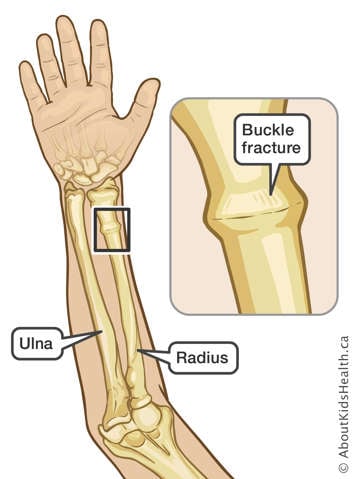
What is a buckle fracture?
A buckle fracture occurs when a bone “buckles”, or slightly crushes in on itself. The most common type of buckle fracture in children occurs in the forearm, near the wrist, usually after a child falls onto an outstretched arm. The injury affects the radius bone in particular.
Where is the radius?
The radius runs from the elbow to the hand. It makes up the forearm along with the ulna, the bone that runs alongside it. The ‘distal’ part of the radius is the part furthest away from the centre of the body, in other words, nearest the wrist.
Buckle fractures occur only in children and are very common. A child’s bones are softer than adult bones and able to bend and compress without fully breaking. Although the bone does not fully break, the fracture can still cause pain.
How are distal radius buckle fractures treated?

When your child goes to the hospital with an injured arm, they will be examined carefully. Often, the doctor will order an X-ray to check if there is an injury.
If there is a buckle fracture of the distal radius, the doctor will recommend a splint to treat it.
A buckle fracture is best treated with a splint rather than a full circular plaster cast. Because the bones are only partially broken, they heal very well within a few weeks with the support and protection that a splint provides. A splint also makes normal daily activities, such as bathing, easier and can often save extra visits to the doctor.
Once it is treated properly, a buckle fracture does not cause any long-term problems with the movement or appearance of your child’s arm or wrist.
What should I expect in the first few days after my child’s injury?
Your child may have some pain in their wrist. If your child is in pain at home, give them ibuprofen or acetaminophen according to your doctor’s instructions.
Your child’s wrist might also be slightly swollen due to the injured tissues and bones. This usually settles within the first one or two weeks. You can help ease swelling by elevating (raising) your child’s injured arm above their chest for the first two or three days. To do this, have your child lie down and place their injured arm on a large cushion or pillow.
When should my child wear their splint?
Your child should wear their splint during the day but may remove it at bath time. For the first week, most children also wear the splint at night for comfort, but you can remove it at bedtime once it is no longer needed for pain control.
How do I remove the splint?
When removing the splint:
- take your time and pay full attention
- make sure that your child is calm
- allow your child to gently and slowly move their wrist
Can my child go back to school or daycare with the splint on?
Your child may return to school or daycare while wearing the splint the day after they hurt their wrist. Make sure staff know that the arm is injured so they can take appropriate care.
When will my child be able to move their wrist and hand normally again?
Most children start to use their wrist and hand again while still wearing their splint. Your child may use their injured arm as it heals but should rest it if they feel pain.
When can my child stop wearing the splint?
Depending on your child’s healing, they can usually stop wearing the splint after two or three weeks. A few children need to wear the splint for up to four to six weeks for comfort.
You should only remove the splint completely when your child’s wrist is no longer in pain. If their wrist is still painful, replace the splint for another week. Repeat this step until the pain disappears.
What should I do if my child keeps removing the splint?
For the first one to two weeks after injury, try securing the straps of the splint with sticky tape.
If your child tries to remove the splint after the second week and appears to be pain-free and willing to use their arm and hand normally, leave the splint off and monitor them. At this stage, the buckle fracture has probably healed and is safe from re-injury except during contact sports.
What should I expect when the splint comes off?
Your child’s arm may be slightly stiff from being in a splint and your child may be a little unsure with their movements to start with. This should pass as the child uses their arm or wrist more.
Once the splint is off, can my child return to all physical activities?
For the first six weeks after their injury, or for about the first three weeks after the splint is removed, your child should avoid physical education, sports, climbing or other activities, such as swinging or using slides, where a fall could re-injure their wrist.
When should my child see a health-care provider about their injury?
It is not usually essential for a child to see a health-care provider about their injury after they leave the hospital. Most children with this wrist injury heal very well and return to their usual activities within four weeks.
If your child needs a follow-up visit to their health-care provider, the health-care team in the emergency department will let you know.
What should I do with the splint once it is removed?
It is best to keep the splint safe for a few days until you are sure your child no longer needs it.